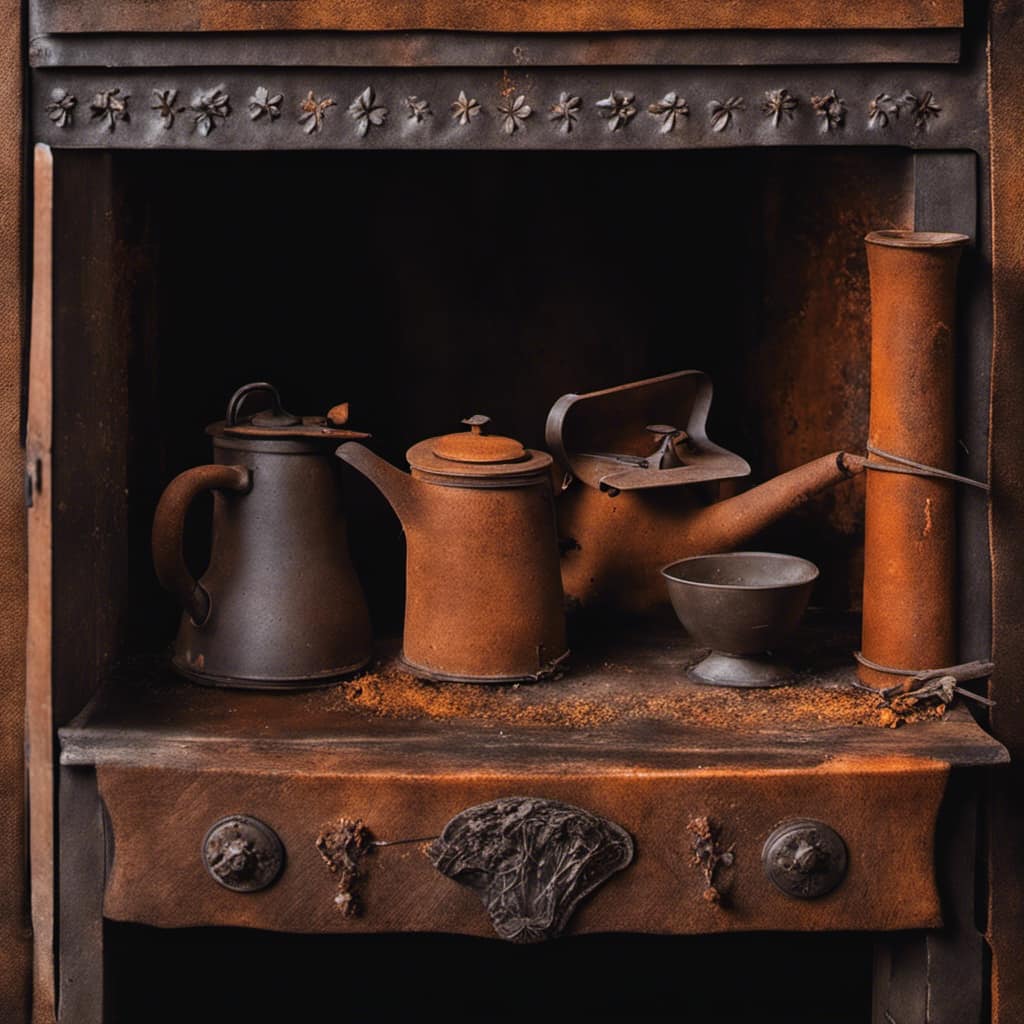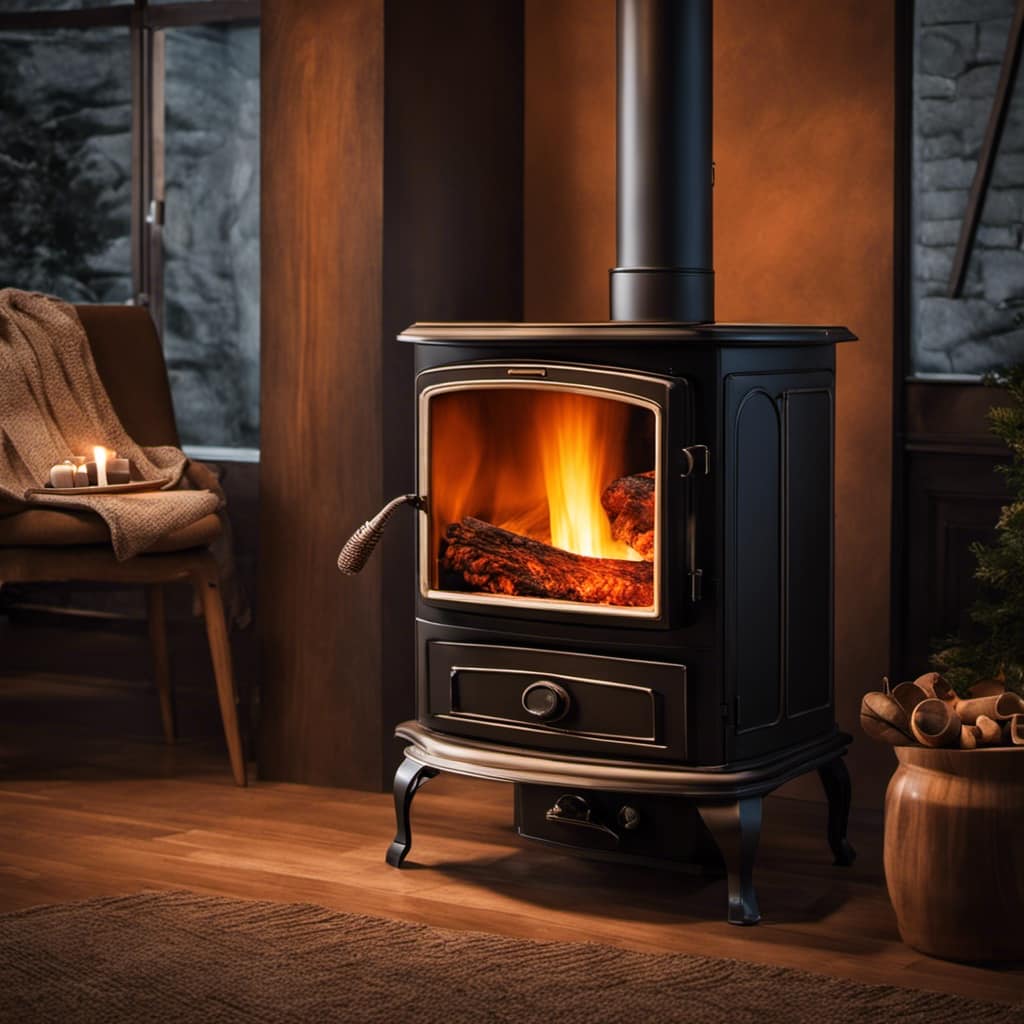
The familiar phrase, “When one door closes, another one opens,” is often heard. However, when it comes to wood stove fires, closing the door could actually put out the flame.
In this article, I will explore potential airflow issues that may cause a wood stove fire to go out when the door is closed. From insufficient draft in the chimney to a damaged door seal, we will delve into the technical details to help you understand why this phenomenon occurs.
So let’s uncover the reasons behind this perplexing problem and find solutions to keep your wood stove fire burning bright.
Key Takeaways
- Closing the wood stove door restricts airflow and affects the combustion process.
- Insufficient draft in the chimney can decrease draft and extinguish the fire.
- A damaged door seal disrupts airflow and reduces combustion efficiency.
- The moisture content of wood greatly affects wood stove efficiency.
Potential Airflow Issues
I think the wood stove fire may be going out when I close the door due to potential airflow issues. Ventilation requirements play a crucial role in maintaining a healthy fire.

When the stove door is closed, the airflow inside the stove is restricted, which can affect the combustion process. Proper ventilation ensures that the fire gets enough oxygen to burn efficiently.
Another factor to consider is the impact of stove placement. If the stove is positioned too close to a wall or furniture, it can impede the airflow, leading to poor combustion and a potential extinguishing of the fire.
To prevent these issues, it’s important to follow the manufacturer’s guidelines for ventilation and stove placement, ensuring proper airflow and a consistent, long-lasting fire.
Insufficient Draft in the Chimney
When the chimney doesn’t have enough draft, the fire in the wood stove goes out. This can be a frustrating experience for any homeowner relying on their wood stove for warmth. Insufficient draft in the chimney is often caused by a lack of proper ventilation or chimney maintenance. To understand the importance of proper ventilation, let’s take a look at the table below:

| Issue | Effect on Draft |
|---|---|
| Obstructed chimney | Decreases draft |
| Inadequate chimney height | Reduces draft |
| Insufficient air supply | Impairs draft |
Maintaining a well-functioning chimney is crucial for ensuring a consistent draft. Regular inspections and cleanings can prevent obstructions and improve airflow. Additionally, ensuring that your chimney is the correct height and providing adequate air supply to the wood stove are essential for maintaining a strong draft. By prioritizing chimney maintenance and proper ventilation, you can avoid the frustration of a fire going out due to insufficient draft.
Damaged Door Seal
The damaged seal on my wood stove’s door affects the draft and causes a loss of heat. When the door seal is compromised, it allows air to leak into the stove, disrupting the proper airflow and reducing the efficiency of the combustion process. To address this issue, here are some troubleshooting steps and tips for door seal replacement:
- Inspect the door seal for any visible signs of damage, such as cracks, gaps, or fraying.
- Clean the seal and the surrounding area to remove any dirt, debris, or ash buildup.
- Measure the dimensions of the seal to ensure you purchase the correct replacement.
- Remove the old seal by carefully peeling it off or unscrewing it, depending on the type of seal.
- Install the new seal, making sure it’s snug and properly aligned.
- Close the door and check for any remaining gaps or leaks.
- Test the stove to ensure the new seal is working effectively.
By replacing the damaged door seal, you can improve the draft and prevent heat loss in your wood stove.
Now, let’s move on to the next section about the moisture content of wood.

Moisture Content of Wood
To ensure optimal performance, I need to monitor and maintain the moisture content of the firewood I use in my wood stove. Wood stove efficiency is greatly affected by the moisture content of the wood. When the moisture content is too high, the wood burns inefficiently and produces more smoke. On the other hand, when the wood is too dry, it burns too quickly and doesn’t provide enough heat.
To help you choose the right type of wood for your wood stove, here is a table that shows the recommended moisture content for different types of wood:
| Type of Wood | Moisture Content |
|---|---|
| Oak | 20% – 25% |
| Maple | 25% – 30% |
| Birch | 30% – 35% |
| Pine | 35% – 40% |
Incorrect Fuel Loading Technique
I need to be careful about how I load the fuel into my wood stove to ensure it burns efficiently and produces enough heat. Improper venting technique and incorrect stove installation can lead to issues with the fire going out when the door is closed. To avoid this problem, here are some important tips to consider:
-
Properly stack the wood: Arrange the logs in a way that allows for proper airflow and ensures a steady burn.

-
Use seasoned wood: Wet or green wood can produce excessive smoke and reduce the efficiency of the stove.
-
Avoid overloading: Don’t fill the stove with too much wood at once, as it can restrict airflow and lead to incomplete combustion.
-
Clean the stove regularly: Remove ashes and debris to maintain proper airflow and prevent blockages.
Frequently Asked Questions
How Can I Tell if I Have Potential Airflow Issues With My Wood Stove?
To determine potential airflow issues with a wood stove, there are several troubleshooting tips. Check for obstructions in the flue or air vents, ensure the damper is fully open, and consider installing a draft-inducing fan as potential solutions.

What Are the Signs of Insufficient Draft in the Chimney?
When troubleshooting airflow issues with a wood stove, signs of insufficient draft in the chimney include smoke backflow, difficulty starting or maintaining a fire, and a lack of heat production.
How Can I Check if the Door Seal of My Wood Stove Is Damaged?
To troubleshoot my wood stove, I began by checking the door seal. I inspected it for any signs of damage or wear, ensuring it was properly sealing when closed. This helped me address the issue of the fire going out.
Does the Moisture Content of Wood Affect the Performance of a Wood Stove?
The moisture content of wood significantly impacts wood stove efficiency. Properly seasoned wood is crucial for optimal performance. When the door is closed, a wood stove fire going out could indicate insufficient airflow or damp wood.
What Is the Correct Fuel Loading Technique for a Wood Stove?
The correct fuel loading technique for a wood stove involves stacking dry, seasoned wood in a crisscross pattern to promote airflow and efficient combustion. Common mistakes to avoid include overloading the stove and using wet or unseasoned wood.

Conclusion
After examining the potential causes for a wood stove fire going out when the door is closed, it’s clear that airflow issues, insufficient draft in the chimney, damaged door seals, moisture content of wood, and incorrect fuel loading techniques can all contribute to this problem.
By addressing these issues and ensuring proper ventilation and fuel loading, homeowners can enjoy a consistent and efficient wood stove fire without any unexpected extinguishments.
Stay warm and cozy with a properly maintained wood stove!
Growing up surrounded by the vast beauty of nature, Sierra was always drawn to the call of the wild. While others sought the comfort of the familiar, she ventured out, embracing the unpredictable and finding stories in the heartbeat of nature.
At the epicenter of every remarkable venture lies a dynamic team—a fusion of diverse talents, visions, and passions. The essence of Best Small Wood Stoves is crafted and refined by such a trio: Sierra, Logan, and Terra. Their collective expertise has transformed the platform into a leading authority on small wood stoves, radiating warmth and knowledge in equal measure.










